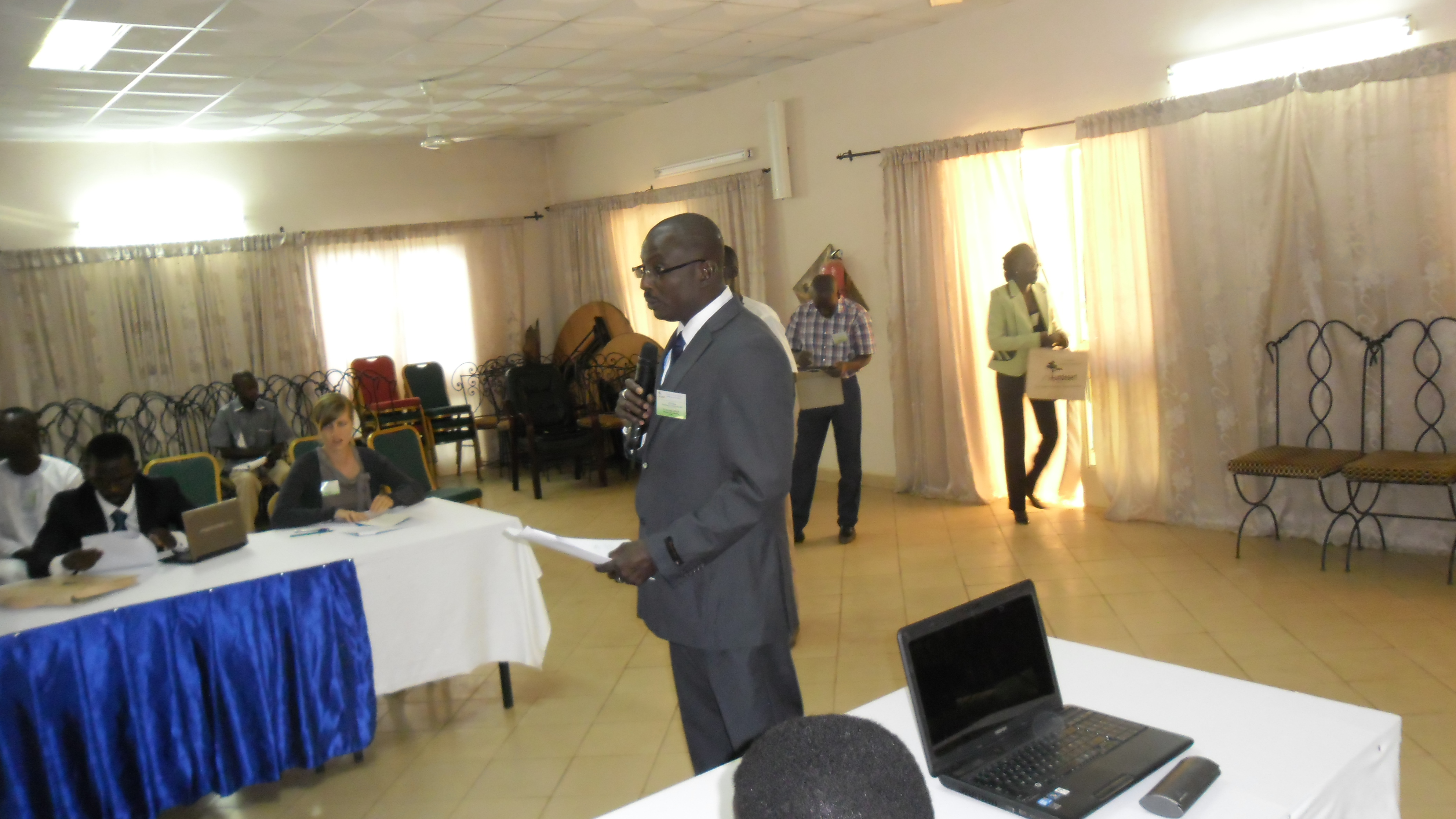Undesert News
UNDESERT NEWS 2015
Atelier régional du Projet UNDESERT du lundi 13 au Mercredi 15 avril 2015 à Niamey (Niger).
Thème: Partage des stratégies de lutte contre la désertification en Afrique de l’Ouest
La cérémonie d’ouverture a eu lieu en présence des coordonnateurs du projet UNDESERT du Burkina Faso et du Niger d’un représentant, des députés nationaux en charge des questions environnementales et membres du réseau des parlementaires du développement rural, d’un représentant du CESOC, , des maires des communes rurales de Simiri et de Tamou, des Enseignants chercheurs de l’Université de Ouagadougou etde l’Université Polytechnique de Bodo Dioulasso au Burkina Faso des Enseignants chercheursde l’Université Abdou Moumouni de Niamey, de l’Université Dan Dicko Dankoulodo de Maradi et de l’Université de Diffa au Niger.


UNDESERT NEWS 2014
1. Ateleir de restitution des résultas aux populations locales à Simiri (Niger): 12/16/2014
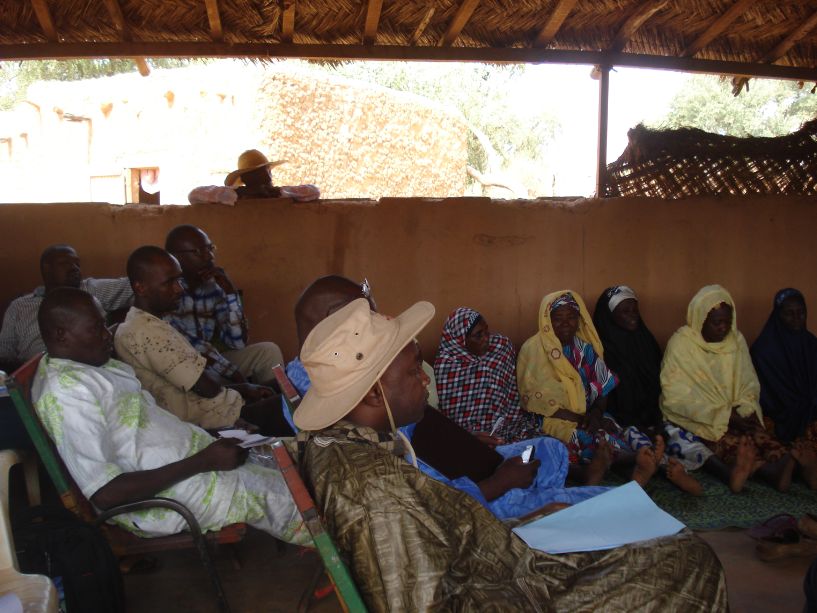
Présentations orales
Effets du Zaï et du Paillage sur les paramètres de fertilité des sols et sur les rendements du mil dans les agroécosystèmes de Simiri (Niger)
La forte pression anthropique sur les ressources naturelles et la baisse du complexe absorbant des sols constituent les principales causes de la diminution des teneurs en matière organique et en éléments minéraux des sols de la zone semi-aride de l’Afrique de l’Ouest. Cette étude, réalisée en 2012 et 2013 dans la Commune de Simiri, a pour objectif d’expérimenter les potentialités de restauration des sols dégradés à travers le Zaï et le Paillage. Le dispositif expérimental est un bloc Fischer randomisé comprenant quatre traitements : Zaï, Paillage, Zaï + Paillage et Témoin. La méthodologie a consisté en des mesures de hauteur de plants, de rendements de mil (variété HKP), de stock hydrique et des prélèvements d’échantillon de sol suivis de leur analyse au laboratoire. L’expérimentation a été de comparer les traitements et d’évaluer les effets sur les paramètres physico-chimiques et le stock hydrique du sol ainsi que sur les rendements du mil. Les résultats montrent que la technique du Zaï et Zaï + Paillage permettent d’améliorer le stock hydrique du sol et la croissance en hauteur de plant de mil. Les fonctions de régressions montrent une dépendance des performances en hauteur des plants de mil au stock hydrique du sol à 79% pour le Témoin et 78% pour le Zaï. Quant à la fertilité du sol, une augmentation significative des valeurs en argiles sont obtenues après deux ans de restauration avec la technique Zaï+Paillage. Cette même techniques a permis une amélioration significative des paramètres tels que : le carbone, le phosphore assimilable, la capacité d’échange cationique et le pH du sol.

Aptitude de trois espèces de Combretaceae à restaurer des terres de plateau en zone sahélienne du Niger.
L’étude a été réalisée dans la commune de Simiri sur un site de terres dégradées de plateau avec comme technique de restauration les banquettes. Cette expérimentation visait à tester l’efficacité des 4 espèces Combretum glutinosum, Combretum micranthum, Combretum nigricans et Guiera senegalensis à restaurer les plateaux à des fins sylvopastorales. La méthodologie a consisté d’abord à délimiter et clôturer le site puis à y creuser les banquettes. Ensuite, des plants de trois espèces ont été produits en pépinière puis transplantés sur le site. Un suivi régulier de la croissance des plants et de l’humidité du sol a été effectué durant 30 mois. Les paramètres mesurés étaient le taux de survie, la hauteur, le diamètre au collet, le nombre de rejets et la biomasse foliaire et le stock hydrique. Un échantillonnage de sol sur le site et une zone témoin a permis d’obtenir des échantillons qui ont été analysés au laboratoire de l’ICRISAT. L’analyse a porté sur les principaux paramètres physico-chimiques du sol. Le logiciel R a été utilisé pour les traitements statistiques. Les résultats ont montré que Guiera senegalensis, Combretum glutinosum et Combretum micranthum, par leur taux de survie, leur croissance d’une part, l’amélioration du pH, de la matière organique du sol d’autre part, sont aptes à récupérer les terres des plateaux.

2. Study stay of African UNDESERT PhD students at Aarhus University/Silkeborg in April-May 2014
In a two month period in April to June 2014, four UNDESERT PhD students and one researcher, Jerome Yameogo from Burkina Faso (University of Bobo Dioulasso), Philippe Bayen from Burkina Faso (University of Ougadougou), Simon Sambou from Senegal (University of Cheikh Anta Diop), Abdou Amani and Boubacar Moussa from Niger (University of Abdou Moumouni) visited Aarhus University/Silkeborg in order to advance on their article projects and to be trained in statistical analysis, scientific writing and soil analysis. The study stay included a course in applied statistics and one in scientific writing. The students applied the statistical methods and the scientific writing skills immediately after the course on their own data and manuscripts and had feedback from the Danish co-supervisors. Soil analysis were conducted in the lab at Aarhus University/Silkeborg.The study stay also improved the south-shouh collaboration between students from different countries working on similar PhD projects.

Photo 1: Participants to statistical analysis training in the lab at Aarhus University/Silkeborg.

3. Study stay of African UNDESERT PhD students at Goethe University/Frankfurt and Aarhus University/Silkeborg in March-April 2014
Between the 14th of March and the 27th of March 2014 two UNDESERT PhD students from Burkina Faso (University of Ougadougou and University of Bobo Dioulasso), Albert Kabaoré and Zezouma Sanon, spent two weeks at Frankfurt University to advance their article projects and to be trained in specific software for their doctoral thesis. They were attended and trained at the Institute of Ecology, Evolution and Diversity of Goethe University Frankfurt and Senckenberg Institute.
The software training included a training in the ecological niche modeling program Maxent 3.3.3 (Phillips et al. 2004), in the remote sensing program ERDAS Imagine 2013 (Intergraph Corporation 2012) and the Geographic Information System ArcGIS 10 (ESRI Inc., Redlands, USA). Furthermore the students were taught how to use different online vegetation databases as the West African Vegetation Database (Schmidt et al. 2010) and the Global Biodiversity Information Facility (GBIF). Data entry was taught in Microsoft Access 2010 (Microsoft Office 2010).
From the 27th of March to the 11th of April 2014 the two students worked for two weeks at Aarhus University/Silkeborg. The study stay included a course in applied statistics and one in scientific writing. The students applied the statistical methods and the scientific writing skills immediately after the course on their own data and manuscripts and had feedback from the Danish co-supervisors
.
4. Atelier de dissimination des résultats aux étudiants de l'Université Abdou Moumouni et de l'Université de Maradi le 26/04/2014 à Tamou (Niger)
Dans le cadre du WP3 et WP5 du Projet Undesert, l’équipe du Niger a mené des activités des restaurations de terres dégradées sur des sites à TAMOU et à SIMIRI. Les résultats obtenus sont satisfaisants à l’état actuel des travaux. Par ailleurs, le WP 7 du Projet prévoie des actions de dissémination des résultats obtenus dans les autres WPs du Projet. C’est dans ce sens que le site de restauration de Allambaré dans la commune de Tamou a été présenté aux étudiants de l’Université de Maradi et de l’Université Abdou Moumouni de Niamey. L’événement a été en collobaration entre le Projet Undesert et les administrations et les structures associatives des deux Universités. Le coordonnateur local du projet Undesert au Niger, le Pr Ali Mahamane a pris la parole pour remercier les étudiants pour avoir accepté de participer à cette manifestation de diffusion des résultats du Projet Undesert. Il a rappelé que le site a été aménagé par le projet SUN-UE en 2007 (Photo 1). Dés lors, ce site présente un grand intérêt pour le Laboratoire Garba Mounkaïla du Département de Biologie de la FAST de l’UAM au vu des efforts de restauration consentis. A la fin de ce projet SUN en 2010, le projet UNDESERT – UE a continué les activités de 2011 à aujourd’hui. Il s’agit d’un suivi de la dynamique des essences plantées, la phytodiversité, les états de surface du sol et de l’humidité. Il ressort des observations directes lors de ce atelier lors de la sortie sur le site Undesert que :
- les espèces plantées ont atteints de caractères dendrométriques assez appréciables 7 ans après l’intervention. Mais l’impact de la technique varie selon les espèces (Photo 2)
- certaines espèces sont déjà productives comme le cas de Ziziphis mauritiana et Acacia senegal (Photo 3) ;
- une amélioration des conditions écologiques de la station (Photos 4)
- Acacia senegal, A. seyal, Bauhinia rufescens seraient les plus performantes.

Photo 1 : Pr Ali Mahamane expliquant la mise en place du dispositif du Site UNDESERT

Photo2 : Appréciation des caractères botaniques des plantes après 7 ans (2007-2014)

Photo 3 : Explication de la technique de production de gomme sur les espèces Acacia seyal et A. senegal
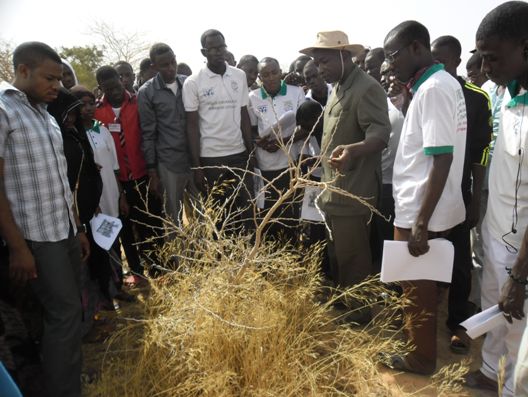
Photo 4 : Inventaire des espèces spontanées temoin de l'amélioration des conditions écologiques
5. Organisation of a workshop by P7 (UPB) in august 21/2014 at Gaoua(Burkina Faso)
Participants: local populations and the officers of technical services (environnemt, agriculture and livestock)
Workshop objectives :
- to share the results of the research led within the context of the project ;
- to sensitize the local populations on the degradation of the natural resources ;
- to attract the attention of the technical services on the state of degradation of the natural resources ;
- to propose some tools of management of the natural resources to the technical services ;
- to have their opinion on the progress of the activities of the project

Vegetation types, floristic diversity and threats on survival of the Classified Forest of Koulbi (Burkina Faso)
Climatic change and Bad agricultural practices (shot-and-burn) is a major source of loss of biodiversity. This study conducted in the classified forest of Koulbi and peripheries aimed to identify different vegetation and to assess tree density by vegetation type and the density of each species. 160 sample units were considered. And in each sample unit, all tree of diameter at breast height more than 05 cm were counted and measured in height. Results: the classified forest of Koulbi is characterized by dry forest, tree savanna Isoberlinia spp, mixed tree savanna, Shrub savanna on degraded soil, shrub savanna (fallow reconstitution) and anthropized area (field, fallow, plantation). The diversity is 134 woody species. The Adult density decreases between dry forest (538 trees ha-1) and the shrub savanna (330 trees ha-1). The main species by vegetation type are: Anogeissus leiocarpa (316 trees ha-1), Pterocarpus erinaceus (23 trees ha-1) and Vitellaria paradoxa (19 trees ha-1) in dry forest. Vitellaria paradoxa (53 trees ha-1), Isoberlinia doka (32 trees ha-1) and Burkea Africana (26 trees ha-1) in tree savanna. Vitellaria paradoxa (55 trees ha-1), Terminalia laxiflora (48 trees ha-1) and Combretum fragrans(21 trees ha-1) in shrub savanna. Afraegle puniculata, Andira inermis, Aphania senegalensis, Celtis integrifolia, Cordyla pinnata, Syzygium guineense and Uapaca togoensis are uncommon in the study area. Yam production, grazing and mortality (9.27%) Anogeissus leiocarpa constitute threats to the survival the classified forest of Koulbi. The forest has a high diversity. However, it remains threatened. There's need to increase protection measures.
Impacts des cordons pierreux végétalisés sur la végétation et les propriétés physico-chimiques du sol
Southwest region, long time considered as "green lung" of Burkina Faso, knows more and more continuing degradation of its forest resources. This degradation might be due to climate change and the pressure of migrants from Central Plateau and neighboring countries in the quest of farmland. To reduce this phenomenon, an experiment was conducted in the rural town of Dissin to test the effectiveness of vegetated stone rows on the rehabilitation of degraded soil. Specifically it came to assessing the impact of vegetated stone rows on the physico-chemical properties of the soil and the vegetation recovery. Has to completely randomized block Fisher experimental device established. Absolute control TA was installed outside of the device, under natural conditions and anthropogenic pressure. After three rainy seasons (2011, 2012 and 2013), the results show that some treatments T3 (stone rows-Piliostigma thonningii), led a light increase of fine particles levels (clay + fine silt) in the interval 2.54 % to 23 % compared to control T0. Regarding soil chemical parameters, managements plots have led to a significant improvement (p = 0.006) of the MO relative to control T0. The C / N ratio has increased slightly. The acidity of the soil decreased inducing an increase of the sum of exchangeable ions. This was more noticed at T3. After three rainy seasons (2011-2013) the management caused regeneration was distinctly superior to the one of controls T0 and TA and contributed to increased woody and herbaceous plant diversity. Among the woody and herbaceous plants , respectively families Combretaceae and Poaceae were most frequently encountered. Woody plant diversity was greater (28 species) in T3. The highest recovery rate (10.14%) was found at T3. T1 treatment (non -vegetated stone rows) was more diversified in herbaceous plants (57 species).
Utilisation et disponibilité de trois plantes (Crateva adansonii D. C., Sarcocephalus latifolius (Sm.) E. A. Bruce et Burkea africana Hook.) dans la région du Sud-Ouest.
The international Convention on biological Diversity aims to protect all species. Plants and animals provide us with food, medicine, habitation, etc. The poor rural population suffers more from the consequences of biological and ecosystem service loss than other people. The objective of our work is to know the use and the disponibility of three useful trees: Crateva adansonii D. C., Sarcocephalus latifolius (Sm.) E. A. Bruce and Burkea africana Hook. We conducted an ethnobotanical survey in 19 villages of the South western region of Burkina Faso. We conducted also some relevés in and outside the protected areas. Results show that C. adansonii is widely used as food, the roots of S. latifolius treat several diseases and the wood of B. africana is used to build houses. The densities of B. african and S. latifolius are higher in the protected areas than around villages. In contrast, C. adansonii is better protected in the villages than in the protected areas. We recommend that everybody adopts a suitable use of the species or a substitute of the species in order to ensure their availability.
6. Workshop on rapid assessment of carbon stock (ERSC) from 8 to 12 September 2014 at Koudougou (Burkina Faso)
Participants: 40 participants from Burkina Faso and Kenya : extension agents, local communities, Foresters, and Political authorities
Overall objective : to strengthen the capacity of participants on the rapid assessment of forest carbon stocks and help communities establish baseline data needed to negotiate with the carbon markets profitably and efficiently. More specifically, the training aims to:
- familiarize participants with the carbon assessment methods (measurement of carbon parcel level, spatial analysis of the coverage, focus groups, and interviews with key informants);
- familiarize participants with key aspects of the proposed carbon ie PIN, PDD, MRV;
- familiarize participants with key aspects of the market and carbon trading;

Photos 1

Photo 2
Photos 1 and 2 : Training workshop for extension agents, local communities, Foresters, and Political authorities
Topic: Contribution to the reduction of human pressure on Patako forest: the issue of buffer zones management.
This activity consisted on sensititsation of local authorities, technical staffs, partners and local communities on the importance of the buffer zone on forest resource sustainability. More than 60 participants from Dakar, Fatick, Keur Samba Gueye and Keur Saloum Diane (Senegal).
UNDESERT NEWS 2013
Third workshop of Undesert project from december 3 to 6/2013 at Kombissiri (Burkina Faso).
Theme: Strategy of restoration of biodiversity and its habitats.
Participants: the workshop was attended by 39 people (Coordination, Reference Group, Researchers, PhD, etc.) from different partner institutions of the project : Aarhus University (Denmark), University of Abomey Calavi (Benin), University of Abdou Moumouni and University of Maradi (Niger), JW Goethe Frankfurt (Germany), University of Ouagadougou and University Politechnic of Bobo Dioulasso (Burkina Faso), Cheick Anta Diop (Senegal) and the Senckenberg institute (Germany).
Participation to the workshop from 9 to 11 September 2013 at Yaounde (Cameroon).
Participates: 75 participants of some technical staff of NGOs, municipal delegates, Foresters and authorities Policies from Cameroon, Burkina Faso, Ivory Coast, Kenya, Senegal, Niger, Cameroon, Central African Republic, Nigeria, Mali, Benin, Togo, Equatorial Guinea, Gabon, Congo, Congo, Burundi, Djibouti.
Aim: to share with research institutions different modules developed in relation to climate change and main objectives :
-to familiarize participants with training needs and research on climate change in the forestry sector;
-to familiarize participants with training modules developed by the AFF in collaboration with resource persons;
- to understanding the role of forests in adaptation and mitigation of climate change;
- to understanding how carbon is valued and traded.
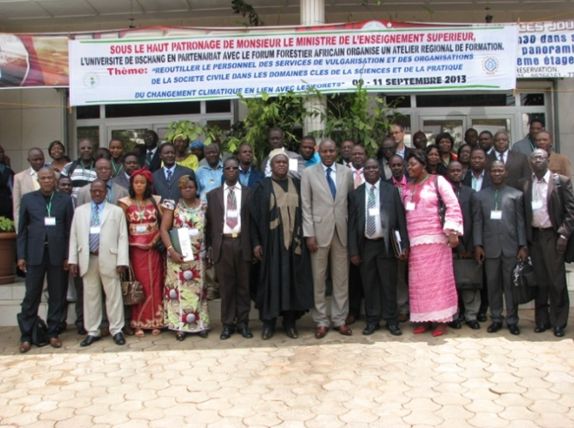
Workshop with research institutions, the universities, the foresters, and authorities Policies from 19 to 21 August 2013 at Ouagadougou (Burkina Faso).
Topic: Retool the staff of national institutions for training and research on climate change and forests
Participants: 50 participants from Burkina Faso, Kenya, Ivory Coast, Kenya, Senegal, Niger, Cameroon, Central African Republic, Mauritania, Nigeria, Mali, Benin, Togo, Guinea, Gabon, Congo, Congo, Burundi, Djibouti.
Objective: The workshop aimed to share technical staffs, NGOs, municipal representatives, forest policies and the different modules developed in relation to climate change.
The workshop included presentation of communications training modules and exercise sessions to digest and amend the training offers.
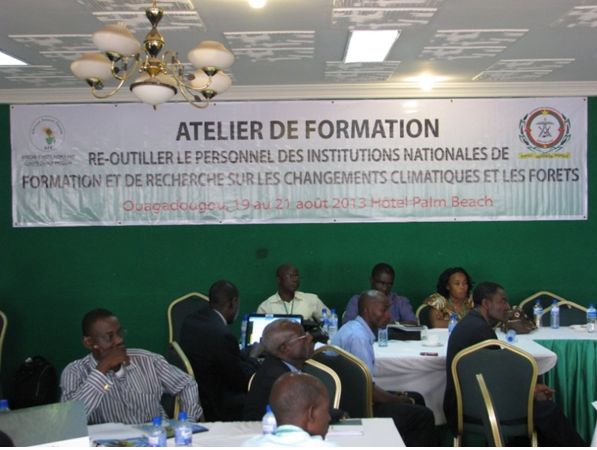
Training workshop (Septembre 2013), Banikoara & Zagnanado, Bénin.
Topic: Bowalization, its impact on biodiversity
Objective: The results of the Undesert project have been shared through training workshop in Benin (Photo). This training was about the practical aspects of strategies for mitigation of desertification and land degradation mainly bowalization.
Participants: The participants were ministries, land use departments, institutions in charge of environmental policies, NGOs (Nature Tropicale, CIPCRE Benin, ECO ECOLO Benin, Eco Benin, CAPES, CLIMA, and CIDEV) and users/ civil society.

UNDESERT NEWS 2012
1. Organisation of a training course on GIS and Remote Sensing by Undesert project in Benin
15th to 24th/02/12 the PhD students of Undesert project were in workshop on GIS and Remote sensing at Abomey Calavi University. The course was given by Yvonne Bachmann (Germany) and Diouf Abdoulaye (Niger). 12 PhD students participated from Abomey-Calavy Unversity (Bénin); Ouagadougou University (Burkina Faso) ; Bobo-Dioulasso Unversity (Burkina Faso) and Abdou Moumouni University (Niger).
Participants list :
Université de Ouagadougou
Elice KABORE
Soungalo SOULAMAAbel KADEBA
Université Abdou Moumouni
Abdou AMANI
Boubacar MOUSSA MAMOUDOU
Université d'Abomey-Calavi
Elie Antoine PADONOU
Myrèse Carmelle AHOUDJI
Farris OKOU
Université Polytechnique de Bobo-Dioulasso
Zézouma SANON
Arnaud Wendpouiré ZIDA
Albert S. KABORE
2. Publication: Catalogue des plantes vasculaires du Burkina Faso
A major step has been taken in the documentation of the Flora of Burkina Faso by the newly published 'Catalogue des plantes vasculaires du Burkina Faso', now incorparating 2067 species, that is c. 70% more than have been known 20 years ago (1203 spp. in Lebrun et al. 1991). In close cooperation, botanists of the University of Ouagadougou, the Senckenberg Research Institute and the Goethe University of Frankfurt compiled this comprehensive work on Burkina's plants including information on taxonomy, ecology and plant use.
The publication builds upon the botanical collections and their respective databases of the University of Ouagadougou Herbarium (OUA) and the Herbarium Senckenbergianum (FR), which have both been largely improved in the recent past by research projects such us BIOTA, SUN and UNDESERT. It is expected to become a major reference for research, education and conservation activities in Burkina Faso and neighbouring countries.
To cite this document: Thiombiano, A.*, Schmidt, M.*, Dressler, S., Ouédraogo, A., Hahn, K. & Zizka, G. (2012) Catalogue des plantes vasculaires du Burkina Faso. Boissiera 65, Conservatoire et jardin botaniques de la ville de Genève. 391 p. (ISBN 978-2-8277-0081-3; *2 first authors: AT and MS contributed in equal parts).
UNDESERT NEWS 2011
Second workshop of the UNDESERT Project from 23 to 25 March 2011 at Fada N'Gourma (Burkina Faso)
Participants: In total more than 50 persons attended the meeting comprising team leaders, WP leaders, staff, students and stakeholders.
The opening session were lead by the Haut Commissaire (the first administrative responsible of the province of Fada N’Gourma), with the presence of university othorities (Director of Faculty of Earth and Life, the Vice-chancellor of University of Ouagadougou).
The last day was spent for common field trip in a core area.
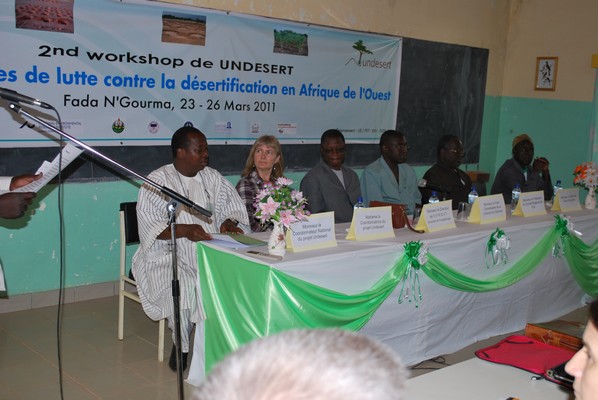

Tracks of the daytrip to the Reserve partielle de faune de Pama (Pama-Nord) in Google Earth format and GPS exchange format

UNDESERT NEWS 2010
UNDESERT kick-off Workshop from 11 to 16 june 2010 at CIEVRA - Allada, 20 km from Cotonou (Benin)
The kick-off workshop of the UNDESERT project (UNDESERT- Understanding and combating desertification to mitigate its impact on ecosystem services) was hold in Benin. This workshop was conducted at the same time as the EU project SUN (Tools for Sustainable Use of Natural Vegetation in West Africa, EU FP6-INCO no 31685, 2007-2010).
Participants: African countries (Niger, Burkina Faso, Benin and Senegal), European countries (Denmark, Germany and Scotland).



Undesert
works to create an improved understanding of the effects of desertification and degradation processes in West Africa and to develop and implement best practices, such as carbon forestry, in close collaboration between scientists and local communities.Financed by EU-FP7.



